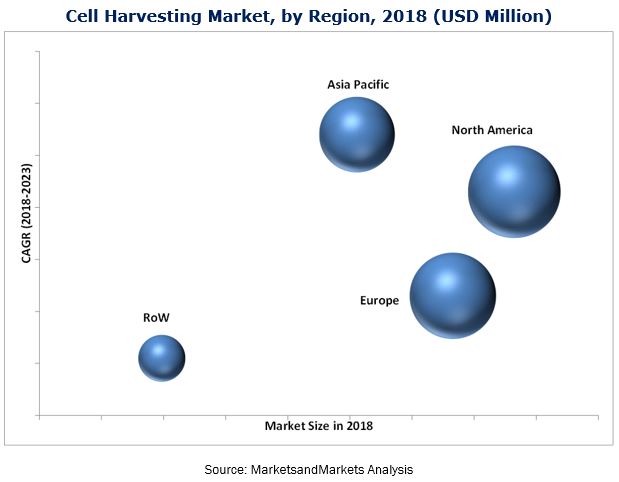The report “Cell Harvesting Market by Type (Manual, Automated), Application (Biopharmaceutical, Stem Cell Research), End User (Biotechnology, Biopharmaceutical Companies, Research Institute), and Region (North America, Europe, APAC, Row) – Global Forecast”, the cell harvesters market is expected to reach USD 324.5 Million, at a CAGR of 8.7%
The Cell harvesting is the process of harvesting cells from the culture media during upstream and downstream bio-processing. Cell harvesters are used extensively for the cell harvesting process and are compatible with a wide range of assays. Rising investments in regenerative medicine and cell-based research, growth of the biotechnology and bio-pharmaceutical industry, and increasing incidence of chronic and infectious diseases are the major factors that are driving the growth of this market.
The objectives of this study are as follows:
- To define, describe, and forecast the cell harvesting market for cell harvesting, on the basis of type, application, end user, and region
- To provide detailed information regarding the major factors influencing growth of the market (drivers, opportunities, and restrains)
- To strategically analyze micromarkets with respect to individual growth trends, prospects, and contributions to the overall market
- To analyze the opportunities in the market for stakeholders and provide details of a competitive landscape for market leaders
- To forecast revenue of the market segments with respect to four main regional segments, namely, North America, Europe, Asia Pacific, and the Rest of the World (RoW)
Request Research Sample Pages:
https://www.marketsandmarkets.com/requestsampleNew.asp?id=209513544
The manual cell harvesters segment dominated the market.
On the basis of type, the market is segmented into manual and automated cell harvesters. In 2017, the manual cell harvesters segment accounted for the largest share of this market. The high share of the manual harvesters segment can be attributed to their ease of use and low price as compared to automated harvesters.
The biotechnology & biopharmaceutical companies segment dominated the market.
In the end user, the cell harvesting market is segmented into research institutes, biotechnology & biopharmaceutical companies, and other end users. In 2017, the biotechnology & biopharmaceutical companies segment accounted for the largest share of the cell harvesters market. The high share of this segment can be attributed to the high prevalence of chronic diseases. Biotechnology & biopharmaceutical companies conduct R&D activities to develop new products for the treatment of these diseases.
Download PDF Brochure:
https://www.marketsandmarkets.com/pdfdownloadNew.asp?id=209513544
Geographical View in-detailed:
The global cell harvesting market is segmented into North America, Europe, Asia Pacific, and the Rest of the World (RoW). While North America held the largest share of the market in 2017, Asia Pacific is expected to register the highest CAGR during the forecast period. As increasing R&D expenditure helps in the development of new treatment solutions, supportive government policies for stem cell research and increasing public-private initiatives to encourage public adoption of stem cell-based treatment in the Asia Pacific countries are driving the growth of the market in this region.
Global Key Leaders:
Some of the major players operating in the cell harvesting market are PerkinElmer (US), Brandel (US), TOMTEC (US), Cox Scientific (UK), Connectorate (Switzerland), Scinomix (US), ADSTEC (Japan), and Terumo BCT (a part of Terumo Corporation) (Japan).






